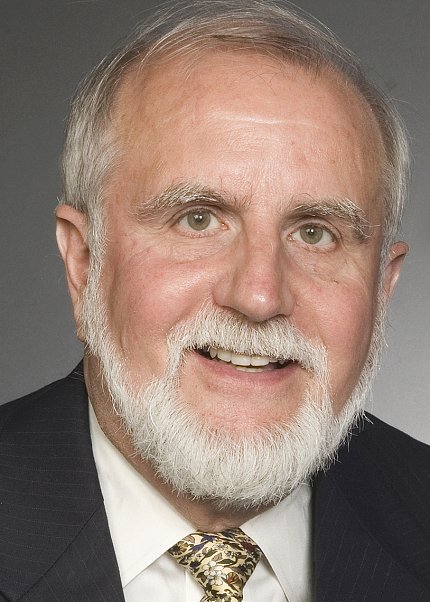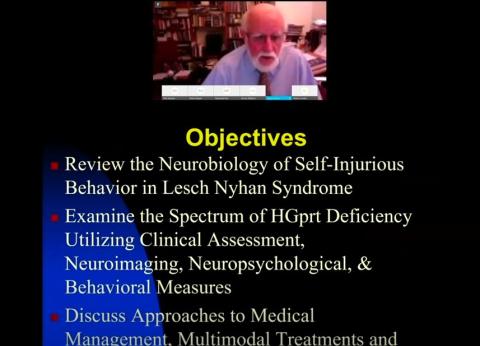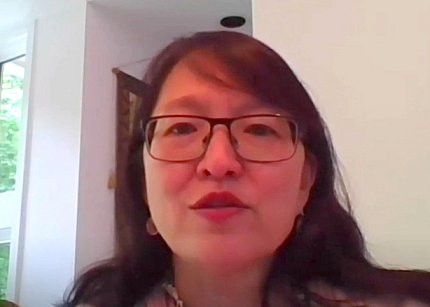Harris Reflects on Decades of Research into Rare Disorder

Severe developmental neuropsychiatric disorders cause patients and their families relentless suffering. Treatment of symptoms may provide short bursts of relief but do little to improve the patient’s quality of life. Determined to improve outcomes for these intractable conditions, investigators have persevered; their longtime research is bringing us closer to better treatments.
One such investigator, Dr. James C. Harris, director, Developmental Neuropsychiatry Clinic and professor at Johns Hopkins University, has devoted more than 30 years to studying neurogenetic syndromes, particularly Lesch-Nyhan syndrome (LNS), in which patients are prone to self-injury.
Harris, who spoke at a June 3 virtual Clinical Center Grand Rounds, showed graphic images of patients’ self-mutilation: a missing finger and lip disfigurement from self-biting and an eye injury from self-hitting. These patients had classic LNS, a genetic disorder also characterized by other aggressive behaviors, dystonic movement disorder and intellectual disability.
This rare syndrome, first described in 1964 by Dr. Michael Lesch, then a medical student, and his mentor Dr. William Nyhan, stems from a deficiency of an enzyme that, 3 years later, NIH’s Dr. Jay Seegmiller would identify as HGprt. The less enzyme present, the more severe the patient’s symptoms.
The amount of HGprt deficiency is based on the type of mutation—there are hundreds of possible ones—of a single X-linked gene. That gene, HPRT1, was first sequenced in the 1980s, around the time Harris came on the scene to study LNS.
Nyhan had described LNS as involving structural deficits in the central nervous system with the characteristic behavioral phenotype of self-injurious behavior. Further research would reveal the syndrome is an X-linked metabolic disorder: the enzyme deficiency causes hyperuricemia—excess uric acid in the blood.
“It was an interesting idea that a behavior could designate a newly described genetic metabolic syndrome,” said Harris, “and [Nyhan’s] description set us off to try to understand what those deficits were.”

Over the years, Harris and his colleagues’ NIH-funded research has delved into the spectrum of HGprt enzyme deficiency, measuring metabolites and studying the underlying neurobiology. Their numerous studies sought to gauge motor, cognitive, linguistic and social abnormalities in LNS patients. He continues to use the latest imaging technologies to analyze brain structure and chemistry, looking at pathways from genes to self-injury.
In classic LNS cases, patients often wear arm restraints to protect against self-injury, though some can communicate when they feel safe enough to loosen them. Harris told the story of a young boy named John who told his caregivers when he felt safe enough to have his restraints released. On one occasion, Harris said, while a caregiver was transferring John from bed to his wheelchair, his hand inadvertently hit his caregiver in the face.
“The caregiver continued as if nothing had happened because if he responded, he’d reinforce the behavior and it would persist,” said Harris. “These children are particularly sensitive to attention to their disruptive behavior.”
Not all LNS patients injure themselves. Classic cases with less than 1 percent HGprt enzyme present with self-injury, but there are variants. Patients who have 3-5 percent enzyme tend to have dystonia and other neurological symptoms but don’t self-injure. Other patients who have closer to 20 percent enzyme also don’t self-injure; they tend to have some motor clumsiness and mild to no dystonia. All of them have hyperuricemia, but treating it has no effect on the self-injury.
“Overall, the variants contribute a great deal because they allow us to look at an extended phenotype,” said Harris. “[LNS variants also allow us] to carry out cognitive and behavioral measures across the full spectrum, keeping in mind that self-injury is one symptom that’s apparent only in classic cases with essentially no enzyme.”

In a recent study with 17 LNS patients compared with healthy subjects, Harris and colleagues found discrepancies in white matter, areas deep in the brain teeming with nerve fibers and encased in a protective myelin sheath that affects motor, sensory and cognitive function.
“I think this is particularly interesting because no one has looked carefully at white matter in LNS before,” said Harris.
Using diffusion tensor imaging, they are finding markedly less white matter in the brains of LNS patients, and the white matter is abnormal.
“Strikingly, the classic Lesch-Nyhan cases are consistently lower in their cognitive capacity on [verbal learning and recognition] tests than the variants and both are quite different from the normal controls,” he said.
Over the years, treatments for LNS have included symptom management, protective equipment along with psychiatric, occupational and speech therapy interventions. Among the pharmacotherapy options, researchers continue to focus on dopamine (D1) receptor antagonists, which may show benefit in treating dystonia and self-injury, said Harris.
A recent, promising clinical trial using the D1 drug ecopipam produced significantly less frequent and severe self-injury but the trial was canceled due to side effects, said Harris, noting that doses may need tweaking in subsequent studies if the drug can again be made available for further study.
“We’re hoping this type of work can be continued,” said Harris, “because the D1 antagonist is the only drug treatment we’ve seen that’s actually been demonstrated to have an effect in a controlled study.”
Another promising treatment, particularly in children with LNS, is a metabolic precursor using the dietary supplement S-adenosyl-methionine (SAMe). Harris is encouraged by the neurobehavioral improvement in SAMe trials, adding that the treatment remains a work in progress that requires refinement. Benefit is reported in approximately 30 percent of adult cases.
As Harris and colleagues fine-tune their understanding of the neurobiological pathways of LNS, another approach—targeted deep-brain stimulation—has helped improve, and in some cases eliminated, self-injurious behavior. He showed a video clip of a patient self-biting, spitting up food and hitting his caretaker at baseline. Later, after deep-brain stimulation, the patient is calm, amicably interacting with others, with no sign of self-injury.
Building on decades of research, new studies renew hope of finding more effective, sustainable treatments for LNS and other developmental neuropsychiatric conditions.
To view the videocast of this lecture, please visit: https://videocast.nih.gov/watch=38042.
